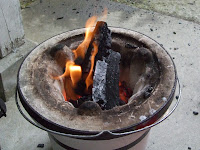
On our summer vacation trip to Tokyo we stayed in Asakusa since my wife found a good bargain at a hotel we had stayed in before. I'm no big fan of that area as it is much too "touristy" for me. That said, I agreed because the price was right and it is just a short walk to the "Kappabashii" area which is the cooking goods and restaurant supply area of Tokyo. I intended to get photos for a blog post on this very interesting area; that should come next week.
Our second evening there, in quest of yaki tori, we came across a new large cloth "kanban" or sign displaying the face of the shop's master. The very same master was twirling small skewers of chicken on a grill facing us through a small window(see picture). The prices on the sidewalk chalk board looked reasonable so we went in.
The 2 storey shop's main floor is narrow with only four tables that I could see without rounding a corner by the kitchen. The other tables were occupied by a family of 3 young girls and their parents and a lone non-japanese customer waiting for the skewers I mentioned before.
The family group was already into their meal and their table was crowded with plates and empty beer mugs.The drama began just after we ordered. I faced the entrance way, as is my custom, and was taking a picture of my son, when I heard a loud crash next to me. Apologies filled the air as the family scrambled to escape a large puddle of draft beer and broken glass. The young father stood rather sheepishly by the table perfectly drenched in the beer that didn't make it to the floor.
Not seeing what had happened, and from prior experience, my first thought was, "fight"! No way, this is Japan.I've only seen 2 fights in 19 years and I caused one of them.(Long story)
The waitress in this newly opened shop had pushed the limit of the table to critical mass and a beer mug had fallen to the floor, soaking the father's pants on the way.More apologies and cleaning ensued as the very cool master joined in and dispatched a young kitchen employee out the door. Fortunately none of the kids was cut as they had managed to slip off their sandals before the incident.
The mess cleaned up and more beer arrived with compliments of the house and I thought the incident finished.
Soon the young kitchen staff returned clutching a large bag marked "Uniqlo". The master gave the bag containing new slacks and underwear to the father who scurried off to change. The end of the story saw the family of tourists leave the shop without paying a single Yen. Master and staff bowing on the way out as they would later do to us while apologizing for the commotion.
Oh, by the way, non-plussed the master's yakitori was excellent. So If you are ever in the Kaminari mon area of Asakusa, across the street from Starbucks you will find a large kanban with a grinning face of a young chef who has his act together.
Below you can see some of the prices for party groups in the upstairs room.
 In a short time it will be 2010, a year of the tiger. I thought it appropriate to post a woodblock print of a bald guy with a tiger.(ukiyo-e, by Utagawa Kuniyoshi).
In a short time it will be 2010, a year of the tiger. I thought it appropriate to post a woodblock print of a bald guy with a tiger.(ukiyo-e, by Utagawa Kuniyoshi).



.jpg)
















